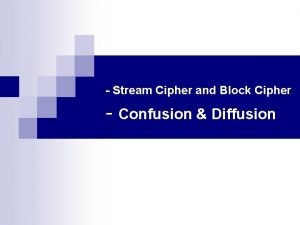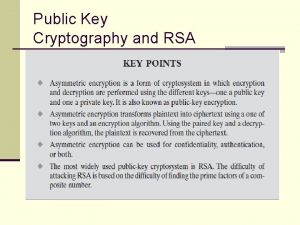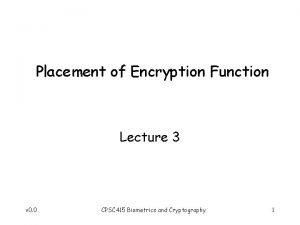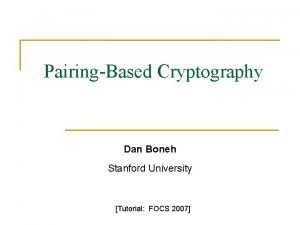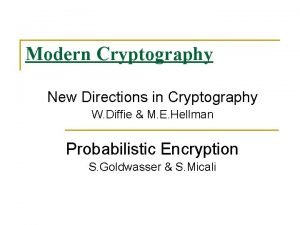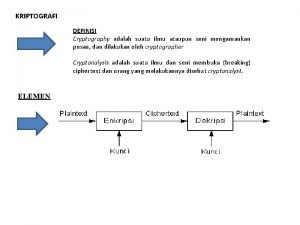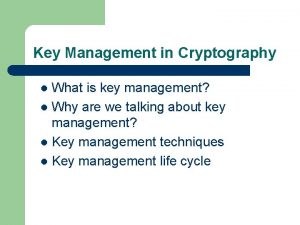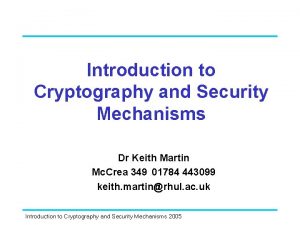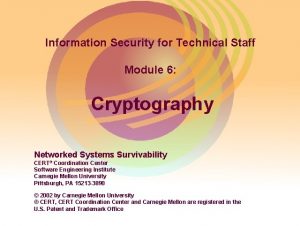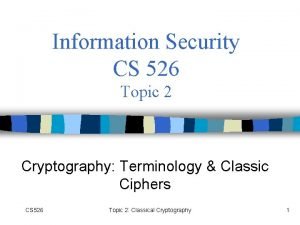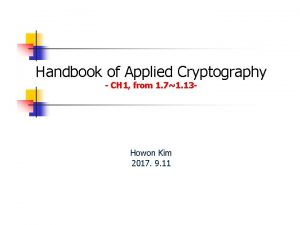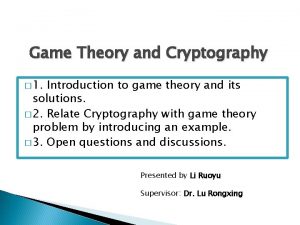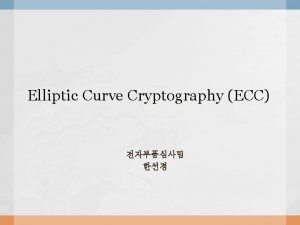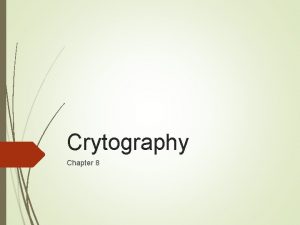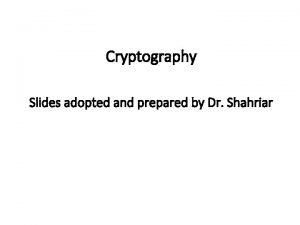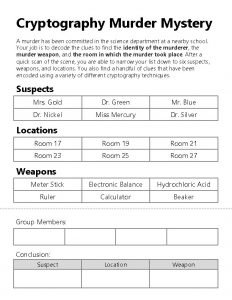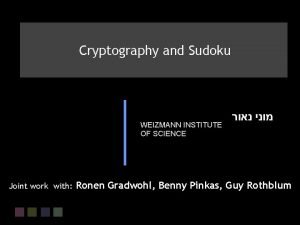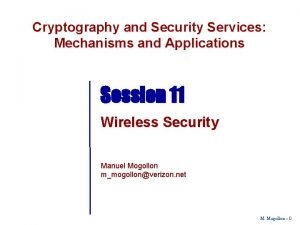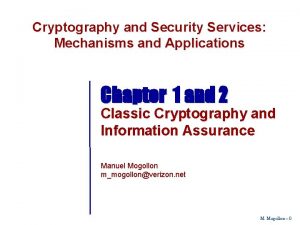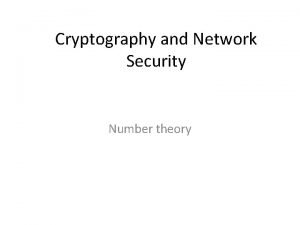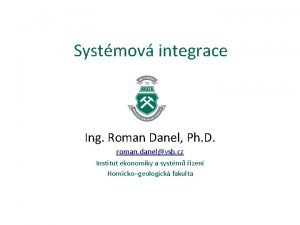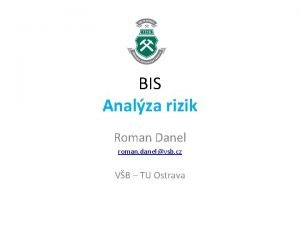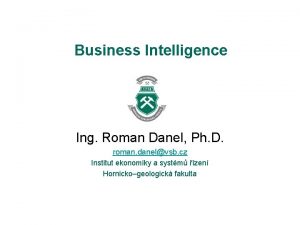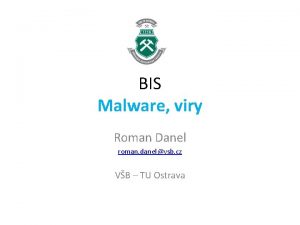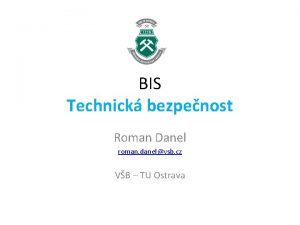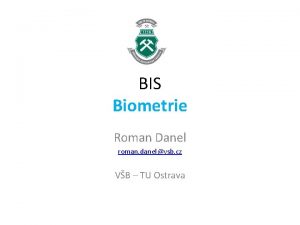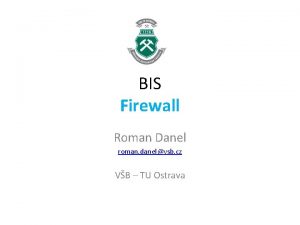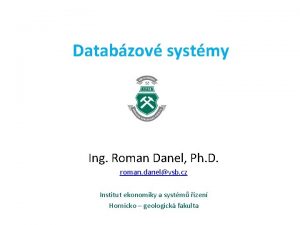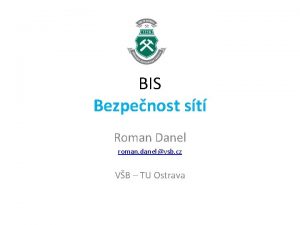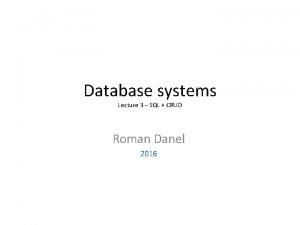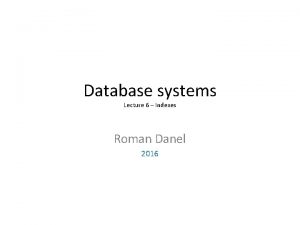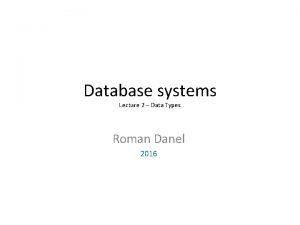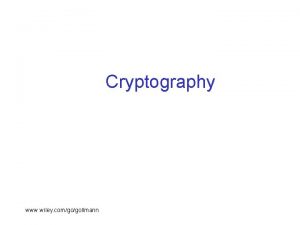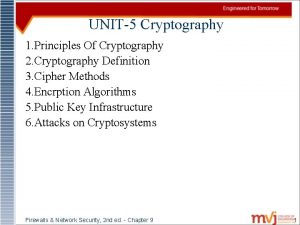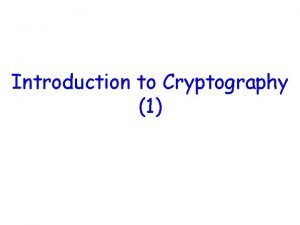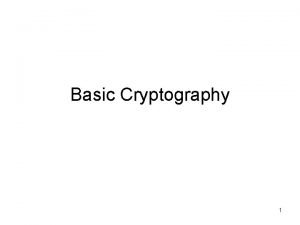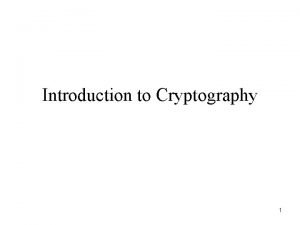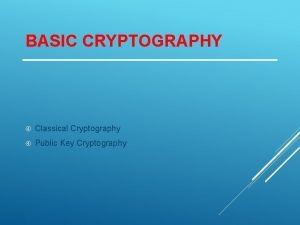Safety of information systems Cryptography Roman Danel roman
















































- Slides: 48

Safety of information systems Cryptography Roman Danel roman. danel@vsb. cz VŠB – TU Ostrava

Cryptology and cryptography • Cryptology - a discipline, dealing with the creation, use, drawing or breaking of ciphers • Cryptography – the science of cipher formation, studying cryptographic algorithms, tools, protocols … • Cryptoanalysis – breaking, breaking cipher • Steganography – hiding messages (not the content)

Encryption Encyption - Encryption of the transmitted information so that it is not comprehensible to a third party. Key – secret information without which the encrypted text can not be read. Hash Functions – A way to create a short string throughout the text that uniquely identifies the original text.

Hash • A one-way function that creates an x-bit length (hash) from an arbitrary long message. • From the output of this function, we are unable to generate input - the original message can not be derived • Hash functions - eg SHA (Secure Hash Algorithm), SHA-xxx where xxx is the length in bits • MD 5 (Message-Digest Algorithm 5) - 128 b

SHA • Designed by the National Security Agency in the US (part of the FIPS) • SHA-1 – hash of a message of 160 bits • Used for SSH, SSL, Ipsec, etc. • 2001 - SHA-2

Encryption types • Symetric • Stream ciphers (Fish, RC 4, …) • Block ciphers (AES, DES, …) It uses a single key to encrypt and decrypt – private • Asymetric Private and public keys.

Symetric encryption Stream Cipher - This is a symmetric based encryption. This encryption is incrementally bit-by-bit using the encryption key, ie each bit is encrypted in particular, and when decrypted, each bit is again decrypted and then merged to the output form - such as a document file. Block ciphers - This is a more advanced encryption that divides the default bit sequence into bit words and then appropriately complements the bit cipher so that all words are the same size. Most recently 64 bit and 128 -bit encryption has been used, and services that require 256 -bit encryption have begun to appear.

Symetric Key

Asymetric encryption • Uses Private and Public key • The sender -> encodes with the public key he has received from the recipient • The recipient -> decrypts with private key

Asymetric Key


Disadvantages of asymetric • More complicated key creation • The downside is speed - slower than symmetrical • Less resistant to brute force attack • Need to verify the authenticity of the key

Digital Signature • Asymmetric key - private key signature • For a symmetric key, anyone who can authenticate the code, can generate it at the same time • The nonrepudiation of the authorship of the signed text is ensure • Authentication - application using sender public key - decrypting gets a hash that compares with hash of sent messages

Certification Authority • Anyone accepting certificate requests verifies, issues, renews, revokes certificates, and publishes a list of invalidated certificates • Trusted CA - root certificate in browser repositories (paid service)

What is a „certificate“? • A file with a structure described in ASN. 1 language – contains information about publisher, owner, expiration date, and public key

Content of Certificate • Version – V 1, V 2, V 3 • Serial number - Certificate number for a given Certificate Authority (CA) for easier tracing • Algorithm of signature - what algorithm was used • Issuer - the name of the CA • Certificate validity - from when the certificate is valid • Entity - for whom the certificate is issued • Public key - mostly RSA (1024 Bits or 2048 Bits) • Using the key - what it will be used for (signing) • Thumbnail algorithm - SHA 1 or SHA 2 • Thumbnail - Certificate hash Source: http: //www. cleverandsmart. cz/

Certificate • The CA certificate will be electronically signed by its root certificate, respectively encrypts it with its private key. • By doing so, the CA confirms that the information on the certificate is true at the time the verification was made.

Certificate classes • Class 1 - The entire process of issuing the certificate is online, and the applicant is not have been checked • Class 2 - Checks the identity of the applicant who must appear personally • Class 3 - the identity of the applicant is checked and the certificates are intended for a specific purpose only

System certificate • To identify the server and establish a secure encrypted connection (SSL / TLS) • Signing messages that will send from this server.

Security of the certificates • Access „defense in depth“ • HSM - Hardware Security Module - Networkaccessible HW certified by Common Criteria access only by authorized persons • Government institution - only recognized electronic signatures with a qualified certificate from an accredited certification authority

FIPS • Federal Information Processing Standards • Public standards of USA governmenet, e. g. : – FIPS 46 – standard for usage of DES – FIPS 197 – standard for AES – FIPS 140 -2 – security of cryptographic systems – FIPS 180 -2 – Digital Signature Algorithm

Common Criteria • Common Criteria for Information Technology Security Evaluation • Standard for computer security certification • Ensures that the process of specification, implementation, and evaluation of a computer security product will be conducted in a strict and standardized way

History of cryptography • Steganography – hiding of texts - invisible inks etc. • Coding – without password, only required knowledge of the code table: – Ancient – substitution cipher - the character is replaced by another character according to the rule – Caesar Cipher - Ancient Rome - Each letter of the message is bent on a fixed number of positions

Caesar Cipher - substitution Source: http: //invisiblecomputer. wonderhowto. com/inspiration/introduction-cryptography-archaic-beginnings-0133735/

History of cryptography • Tables of substitutions – characters substitution without any internal context • Vigener‘s Cipher – Caesar Cipher enlargement, 16 th Century – The variable length is used to move the text – The character shift in the alphabet based on the password, ie for each occurrence of the character differently – Broken by Charles Babbage

Vernam's cipher • Vernam Cipher - Added to open text and password, the password is a random block of the same size as the open text • The only inexplicable but difficult job • „One-time pad“ - a one-time table cipher

History of cryptography • Transposition ciphers - change the order of characters according to a rule • Combined ciphers • Encryption by machine - Enigma • Modern symmetric ciphers - DES, AES • Encryption - XOR (Exclusive Sum) • Quantum cryptography

Enigma • Main Components - Keyboard, Interface Board, Scrambler, Mirror, Cipher Display. • Principle - scramblers are rotating and change the cipher letter after pressing each key. The interconnection plate exchanges pairs of characters. Number of combinations of about 1017. • Broken for World War II - Alan Turing

Enigma Source: http: //cryptomuseum. com/crypto/enigma

Enigma

DES – Data Encrypted Standard • DES was developed in 1977 and is considered to be inadequate as it uses only 54 bits for encryption • The cipher can be cracked using a brute force method in approximately 24 hours by the standard computer of today. • Feistel's cipher

Blowfish - The cipher is a work of B. Schneier and was first published in 1994. It is a cipher with a block size of 64 bits and a key length of at most 448 b (ie 56 B). The author created this cipher as an unlicensed alternative to DES, but unlike DES, it has not been broken yet

Blowfish • Symmetric block cipher • The algorithm consists of two parts: – Key Expansion - Converts a key with any length to several subkey fields, these subkeys must be precalculated, computationally demanding – Data encryption - 64 -bit blocks in 16 rounds, runs fast • All operations used in the algorithm are XOR and addition of 32 -bit words

Advantages and disadvantages of blowfish • One of the fastest block cages with wide use • Each new key needs preprocessing the same as encryption of 4 kilobytes of text, which is very slow compared to other block ciphers. This prevents use in certain applications. • Yet provides sufficient protection against "dictionary attacks"

Usage of blowfish • t is not suitable for encryption of large databases • Keys occupy 4 k. B => Can be used on older computers • Software to encrypt documents on CDs, flash drives, smart cards • Pu. TTY: A Free Telnet / SSH Client

Twofish • • Blowfish folower Key up to 256 bits Free available Usage: Photo. Encrypt, GPG and open source software True. Crypt.

AES – Advanced Encryption Standard It was created by the US government to encrypt its documents. • The key size can be 128, 192 or 256 bits it has not been broken yet. • Used in Wi. Fi (WPA 2 security) • 1997, 2002 - US federal standard

AES • A brute force attack against AES with a 256 -bit key would require 2200 operations, so the total calculation would take much longer than the overall age of the universe.

Asymetric cipher • Use 1 - to encrypt the recipient's public key, to decrypt the private key of the recipient. The message reads ONLY the authorized recipient • Use 2 - to encrypt the private key of the sender, to decrypt the public key of the sender. The recipient demonstrates the identity of the sender (eg electronic signature. . . )

RSA • Asymmetric encryption • Public and private key • http: //www. cleverandsmart. cz/zakladykryptografie-pro-manazery-rsa/

PGP • Pretty Good Privacy, 1991 • Based on RSA, digital signature, a combination of symmetric and asymmetric encryption • Open. PGP Internet Standard • Gnu. PGP - Linux • Message digest - ensuring authenticity • http: //www. pgpi. org/

Attacks • Bruce Force Attack – Most versatile – All possible combinations are tested – MIPS - Million operations per second • 8 bit key – 256 ms within speed 1 MIPS • 128 b key – 5. 1024 years

Attacks • Cipher Only Attack Knowledge • Known Plaintext Attack • Cracking with Selected Open Texts (Chosen Plaintext Attack) • Cracking with taking knowledge of selected encrypted texts • Cracking with user compromise • Timing Attack

PKI • PKI (Public Key Infrastructure) - the infrastructure of administration and distribution of public keys from asymmetric cryptography.

What does PKI involve? • • digital certificates encryption keys asymmetric cryptography certification authority network security architecture way of safe issuance of certificates tools for managing, restoring, and deleting certificates

Electronic Signatures • An electronic signature is used to ensure of the author and the integrity of signed data. • The electronic signature is the application of asymmetric cryptography (ie. Public-key cryptography). • Czech Republic: Act no. 227/2000 Coll.

Electronic Signature

Data Boxes (Czech Republic) • The data box is in the Czech legal system since 2009, defined as an electronic repository special type established under the Act no. 300/2008 Coll. , which is designed to deliver electronic documents between public authorities on the one hand, and natural and legal persons on the other side (January 1, 2010 natural and legal persons among themselves). • The data box is mandatory for state authorities and legal persons registered in the Commercial Register is voluntary for most employed individuals, it may establish and residential customers.
 Safety contour safety depth
Safety contour safety depth Safety care training
Safety care training Personal safety vs process safety
Personal safety vs process safety Safety assessment for ind safety reporting
Safety assessment for ind safety reporting Basic safety construction site safety orientation
Basic safety construction site safety orientation Basic safety orientation
Basic safety orientation Cursus honorum
Cursus honorum Roman republic vs roman empire
Roman republic vs roman empire Ladder climbing safety system
Ladder climbing safety system Ogden safety systems
Ogden safety systems Pipeline safety management system
Pipeline safety management system Southall safety cloud 2
Southall safety cloud 2 Food safety management systems servsafe chapter 8 notes
Food safety management systems servsafe chapter 8 notes Crane safety systems
Crane safety systems Decision support systems and intelligent systems
Decision support systems and intelligent systems Principles of complex systems for systems engineering
Principles of complex systems for systems engineering Embedded systems vs cyber physical systems
Embedded systems vs cyber physical systems Engineering elegant systems: theory of systems engineering
Engineering elegant systems: theory of systems engineering Expectedness
Expectedness New directions in cryptography
New directions in cryptography Confusion and diffusion in cryptography
Confusion and diffusion in cryptography Blaise de vigenere cryptography
Blaise de vigenere cryptography Principles of public key cryptosystems
Principles of public key cryptosystems Explain about the placement of encryption function.
Explain about the placement of encryption function. Stanford university cryptography
Stanford university cryptography Dan boneh blockchain course
Dan boneh blockchain course Wireless security in cryptography
Wireless security in cryptography New directions in cryptography
New directions in cryptography Cryptographer adalah
Cryptographer adalah Key management in cryptography
Key management in cryptography Cryptography
Cryptography Quiz: module 06 basic cryptography
Quiz: module 06 basic cryptography Kerckhoffs’s principle
Kerckhoffs’s principle Cryptography
Cryptography Handbook of applied cryptography
Handbook of applied cryptography Cryptography board game
Cryptography board game Motivationsbasis
Motivationsbasis Greek cryptography
Greek cryptography Cryptography slides
Cryptography slides Cryptography summary
Cryptography summary Cryptography murder mystery
Cryptography murder mystery Hieroglyphics definition
Hieroglyphics definition Sudoku crypto
Sudoku crypto Cryptography security services
Cryptography security services Cryptography security services
Cryptography security services Primitive root in cryptography and network security
Primitive root in cryptography and network security Modulo table
Modulo table Fermat's theorem in cryptography and network security
Fermat's theorem in cryptography and network security криптографический модуль
криптографический модуль




















